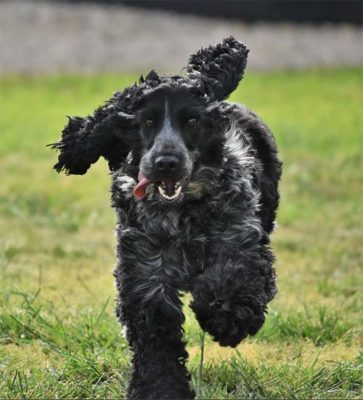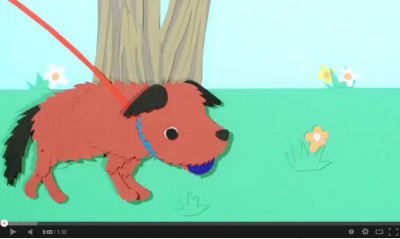One would have thought that Harry, the adolescent Cocker spaniel had all he could want to be happy with life. His loving owner, Jill walked him twice a day, a definite highlight for Harry who exuberantly greeted every person and dog he saw. He enjoyed mental enrichment through fun training for treats daily and went to puppy day care for extra play time each week. At night he slept in his bed near Jill’s and she had set up a comfy spot in the main living area for him when she went out.
However, Jill became concerned that Harry was not as happy as he could be. With the upheaval of the house renovations, it became more noticeable that Harry was not coping when she went out. He had become destructive and barked when he was left alone. He would whine when Jill went out of sight inthe next room. Harry was constantly seeking attention by nudging Jill and jumping up. Jill tried not to reinforce this behaviour by ignoring it, however he would nag her more and mouth her to gain attention. Harry paced restlessly and only relaxed when he was in close contact with Jill. It got to the point that he was so anxious when alone that he would not touch his food or water until Jill came home.
When Jill brought Harry in for a behaviour consultation, it was no surprise when he was diagnosed with separation distress, a form of anxiety disorder. Harry was not being naughty. Rather his behaviour was a sign that he was anxious and distressed when alone. His pacing, barking and destructive behaviours were his efforts to find Jill and cope with the uncomfortable feeling of anxiety. Dogs suffering from separation distress can show a range of signs. Some may injure themselves or property in a desperate attempt to escape and find their owner whilst others suffer in inconspicuous silence, trembling and salivating until the owner returns. Sadly, many that vocalise their anxiety are labelled as nuisance barkers and fitted with aversive collars that trigger with each bark and increase anxiety.
As for humans who suffer from anxiety, our canine companions can experience ‘amygdala hijack’, when the danger-brain works overtime and perceives threats that are not real. Rather than functioning in a calm and logical way, Harry’s brain reacted fearfully whenever he was alone. Anxiety is a physical disease linked with an imbalance of certain neurochemicals in the brain and tends to become worse over time. Every time Harry reacted anxiously to a perceived threat or panicked about being left alone, the neural pathways for the fear reaction become strengthened.
Like any behaviour problem, genetics, past learning and the present situation all contribute to the cause.
Treatment is aimed at:
1. Managing the imbalance in Harry’s brain with anti-anxiety medication and calming pheromones.
2. Improving resilience and fostering a calm emotional state through behaviour modification exercises that positively reward calm.
3. Managing Harry’s environment to help him to feel safe when alone.
Video footage is often helpful to assess the response to treatment by revealing the pet’s body language when they are alone.
Jill embraced the treatment plan with a strong commitment to help dear Harry become a happier dog. It’s 16 months further on now and Jill is very happy with his progress.
Some comments from Jill
Harry is not the first dog to be a large part of my life but he is the first to display behavioural problems. He was destructive, continuous barking and unable to settle down or relax.
After Harry’s anxiety diagnosis, the plan included medication to help alleviate his stress and a job for me to modify his environment and my actions. This was and still is a trial and error arrangement with initially error being the main result. Over time I have come to understand Harry’s anxiety so that now his good days (less anxiety) far outweigh his bad days (anxiety driven).
I am still learning and will continue to learn what causes his anxiety. For example, yesterday I received a phone call which resulted in me immediately leaving him alone and being absent for about 4 hours. I returned to a very anxious Harry. I had previously learnt that Harry needs more notice before being left alone at home, unfortunately I didn’t consider this yesterday.
Harry is worth the commitment to make his life as happy as I can, he is definitely a ‘keeper’ and I wouldn’t have it any other way.



 Like people, many pets suffer from forms of anxiety. If your pet cannot settle during thunderstorms or fireworks or perhaps your pet cannot settle if you are not present, then talk with Dr Helen Purdam about some strategies to help the both of you cope.
Like people, many pets suffer from forms of anxiety. If your pet cannot settle during thunderstorms or fireworks or perhaps your pet cannot settle if you are not present, then talk with Dr Helen Purdam about some strategies to help the both of you cope.

 Dogs need exercise, some more than others. Working breeds require more regular exercise but even a couch-potato enjoys some outdoor entertainment. They all appreciate walks at different times of day and in variety of places, from the bush to the beach.
Dogs need exercise, some more than others. Working breeds require more regular exercise but even a couch-potato enjoys some outdoor entertainment. They all appreciate walks at different times of day and in variety of places, from the bush to the beach.
